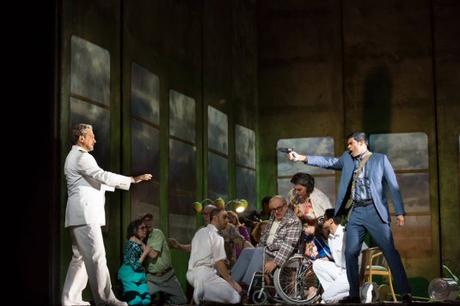 The Met Opera’s staging of The Death of Klinghoffer, with Paulo Szot (left) as the Captain, and Sean Pannikar (right) as the Terrorist (Photo: Met Opera)
The Met Opera’s staging of The Death of Klinghoffer, with Paulo Szot (left) as the Captain, and Sean Pannikar (right) as the Terrorist (Photo: Met Opera)The Time of the Season, Such as It Was
No matter what the classical music press may say or the company’s management might do to convince us otherwise, this was not the most impressive Metropolitan Opera radio lineup in many a season. But it did have its moments. And it has certainly been a most assorted if not exactly varied one.
There’s always loose talk among those purportedly in the know of how staid and stale the repertoire has gotten. Perusing the contents of the Met’s Live in HD and Radio Program Guide for the 2016-2017 Season, one can spot such obscure novelties as Kaija Saariaho’s L’Amour de Loin (“Love from Afar”), a newly commissioned work; a modern-esque production of Gioachino Rossini’s Guillaume Tell (in the original French!); and Franco Alfano’s Cyrano de Bergerac, an unearthed verismo gem from the 1930s.
Old favorites — for example, the perennial Zeffirelli production of La Bohème, and Sonja Frisell’s lavishly embroidered Aida — continue to hog the limelight, giving way to a plethora of more current re-workings of Don Giovanni, Manon Lescaut, Hansel and Gretel, The Barber of Seville, Rigoletto, Carmen, Werther, La Traviata, Fidelio, Eugene Onegin, The Flying Dutchman, and Der Rosenkavalier. Hey, is it intermission time yet?
But seriously, unless these standard-issue items are laced with top-of-the-line models, there would be no motivation on Earth to attempt to resurrect them — except, of course, to attract paying audiences to fill the company’s seats. Our nation’s opera companies have undergone such financial upheavals in the past few decades that anything smacking of the “adventurous” is immediately looked upon with misgiving.
Taking a slice out of operatic life, a few years back, in November 2014, the Metropolitan tried its hand at presenting a controversial staging of John Adams and Alice Goodman’s The Death of Klinghoffer. Although it is more in the tradition of an oratorio, the story concerns the 1985 hijacking of the cruise ship Achille Lauro by Palestinian terrorists and the murder of a retired Jewish-American passenger, the wheelchair-bound Leon Klinghoffer. Not to make light of a serious situation, this is what used to be known in the industry as “CNN Operas” or, in the good old days of Hollywood, a subject “ripped from today’s headlines.”
Because of the inflammatory nature of the plot, protesters and pro-Zionist organizations (to include New York City’s former mayor Rudolph Giuliani) decided to come together and demonstrate vehemently in front of Lincoln Center Plaza, decrying the Met and its general manager, Peter Gelb (himself of Jewish origin), for putting on such a despicable program. To avoid further controversy, Gelb cancelled both the Live in HD transmission and the planned radio broadcast of the work. That’s telling them, Pete — NOT!
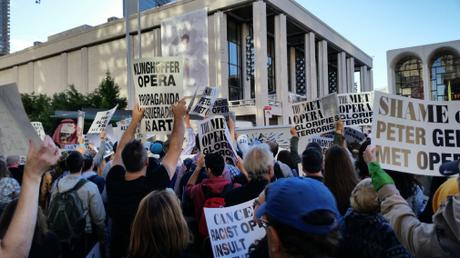
As it developed, the majority of protesters had never seen the production when it initially premiered much less heard any of the music. To quote from music critic Alex Ross’ excellent New Yorker review, all they knew about Klinghoffer was that it “glorified terrorism” (which it did not), that it was “anti-Semitic, pro-terrorist, anti-American, anti-British, anti-gay and anti-western world.” Phew, did they leave anything out of their diatribe?
Such excessively politicized over-reactions to an operatic treatment of a highly publicized atrocity from the recent past may not have been entirely unexpected. While they were within this nation’s capacity to express opposing viewpoints (to be defended at all costs, by the way), there was no reason to attribute the above sentiments to a work that tried to look at all aspects of the event, no matter how horrible the ultimate outcome.
Artistic license allows for some leeway in depicting thorny and hard-to-swallow subject matter. Verdi was one of those individuals who knew how to juxtapose the past with present concerns, and still make them stick in the listener’s mind. In fact, the Met’s staging of his early triumph Nabucco (read my review of their production: https://josmarlopes.wordpress.com/2017/04/09/met-opera-round-up-singing-the-broadcast-blues-part-two-nabucco-la-boheme-and-romeo-et-juliette/) followed this basic blueprint.
We must not neglect the fact that what Verdi was dealing with was a musical and lyrical representation of so-called “history.” In the case of Nabucco, it was the Hebrew enslavement by King Nebuchadnezzar — known as the Babylonian Captivity — and the slaves’ yearning for freedom from bondage, a familiar Biblical theme.
During the time of Nabucco’s premiere, parts of Italy were ruled by the Austrian Empire. And during Verdi’s youth, the town of Le Roncole, in the northern province of Parma, was governed by French forces (trivia note: the name on his birth certificate was Joseph, not Giuseppe). Therefore, it was easy for Italian audiences to relate themselves to Verdi’s viewpoint, hence their identification with the oppressed and the opera’s immediate popularity.
One could say as much for Camille Saint-Saëns Samson et Dalila, a similar depiction of the Old Testament strongman from the Book of Judges where Samson battles the evil-minded Philistines with the jawbone of an ass. Its familiar seduction scene — you know, the bit about Samson getting a haircut from the temptress Delilah, which deprived him of his strength — is one of those eye-rolling episodes that tend to give opera a bad name.
Still, the mighty Samson was never as contentious as, say, Verdi’s Rigoletto in which the censors objected to the licentious nature of Francis I, which compelled the composer to transform the royal personage into the lowly Duke of Mantua as well as change the setting from France to medieval Italy; or his later Un Ballo in Maschera, wherein the Maestro attempted to portray the onstage assassination of King Gustav III of Sweden, which earned the antagonism of overly nervous censors, thus forcing Verdi to move the location of his opera to Colonial Boston(!) of all places.
This brings up the obvious question: Should the Met have approached Adams and Goodman with a similar suggestion? Let’s say, change the locale of Klinghoffer from an ocean liner to a starship? Why not make the opera an outer space, science-fiction adventure tale of repression? How about calling it Revenge of the PLO Sith?
Anything is possible for the sake of preservation of the art form. You think I’m joking? To take just one example, there have been plenty of “modernized” realizations of Wagner’s Ring cycle where the participants are costumed in space-age garb. And where would the Forest Murmurs episode in Siegfried occur? On Endor, of course!
Now, I know I’ve been waxing and waning toward the ridiculous, but as long as there is someone, somewhere willing to squeeze every last ounce of topicality out of contemporary productions (in a good way, to be certain), one can be assured of opera’s continued relevance and existence in the twenty-first century.
And Now, for Something Completely Different
Meanwhile, the list of works to be reviewed grows long. Suffice it say that those Met Opera broadcasts meriting inclusion into this blog have whittled themselves down to a precious few: a revival of Vincenzo Bellini’s final masterpiece I Puritani, Massenet’s romantic Werther, Rossini’s stirring Guillaume Tell, Wagner’s ghostly Der Fliegende Holländer (or “The Flying Dutchman,” with corresponding allusions to filmmaker Gore Verbinksi’s Pirates of the Caribbean series), and finally Alfano’s Cyrano de Bergerac, a work unfamiliar even to me.
Let’s begin with the Bellini opus, the full title of which is I Puritani di Scozia (“The Puritans of Scotland”). When this Sandro Sequi-Ming Cho Lee production first premiered back in 1976, the big-name cast boasted the likes of Joan Sutherland, Luciano Pavarotti, Sherrill Milnes and James Morris in the principal roles. The conductor was musicologist and bel canto expert Richard Bonynge, Ms. Sutherland’s husband.
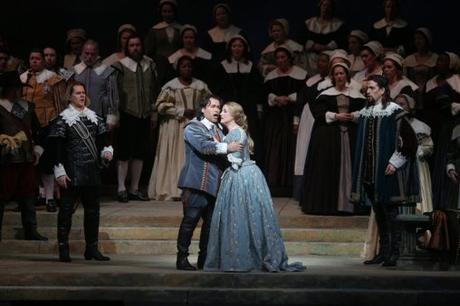
Though the version heard was far from complete, it at least gave listeners a reasonable facsimile of how these voices would sound in what was generally accepted as a field day for singers. There was a palpable excitement in the air and a feeling of anticipation, especially when Luciano joined Dame Joan in their hair-raising last act duet, “Vieni, fra queste braccia.” We were also treated to the justifiably famous Act II scene for baritone and bass, “Suoni la tromba,” splendidly executed by Milnes and Morris. The shouts and bravos that greeted all these artists went on and on, such was the reception they garnered at the time.
Critics had to reach all the way back into the previous century for comparisons. To be fair, though, the Metropolitan did not have as glorious a performance history with Puritani as it had with Bellini’s Norma or La Sonnambula, since these works did not necessarily depend on first-rate casting in every part. But Puritani needs the best that an opera company can hire. Caruso never sang Arturo, but Giacomo Lauri-Volpi had an early success with the role, with high Cs and Ds intact. Elsewhere, tenors Alfredo Kraus and Nicolai Gedda lent class and distinction to their live performances, along with melting lyricism.
However, if memory serves me, I seem to recall that the New York City Opera under its conductor-director Julius Rudel had revived I Puritani a few years before the Met. There was a time when the NYCO was tops in its class for heralding new and unfamiliar works. My family and I were privy to a matinee performance of Puritani featuring the effervescent Beverly Sills, with Enrico DiGiuseppe, Pablo Elvira and Robert Hale. Unlike the Met’s fuller version, the City Opera’s Tito Capobianco production was riddled with cuts, especially in Act III; it also struck me as being needlessly rushed, as if Rudel were in a hurry to get it over with and go on to something else.
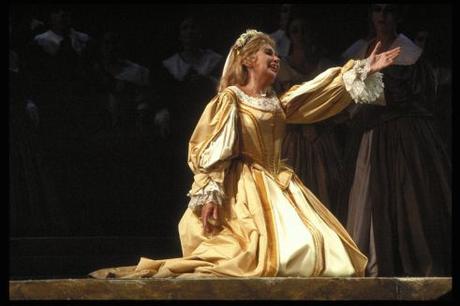
While La Sills had not yet made her Met Opera debut, she was no doubt Manhattan’s reigning bel canto queen. On that occasion, though, she seemed lacking in spark and vigor, quite unlike her bouncy old self (her nickname happened to be “Bubbles”). The other singers somewhat made up for the lack of fireworks, with Elvira and Hale delivering a rousing close to Act II. Tenor DiGiuseppe put on a brave front in the punishing part of Arturo. He navigated the wide-ranging tessitura well enough, but discomfort was evident as he moved higher and higher up the scale.
Now, when Diana Damrau teamed up with Javier Camarena at the Met, the SRO (standing-room-only) crowd knew these more than capable artists were going to give it their best shot as Elvira Walton and Lord Arturo Talbot, especially at the February 18, 2017 radio broadcast.
Damrau’s entry in Act I was accompanied by a mellow, though far from mellifluous Luca Pisaroni as her uncle Giorgio Walton. Earlier, Russian baritone Alexey Markov struggled with the coloratura aspects of Riccardo Forth’s opening aria, “Ah! Per sempre io ti perdei.” Sounding much like the Italian baritone Ugo Savarese (a second-rate singer at best, who may be familiar to record owners as Count di Luna on the old London/Decca LP of Il Trovatore with Tebaldi and Del Monaco), Markov’s timbre and rather modest means was swamped by the chorus and orchestra.
In contrast, the ovation that greeted Javier Camarena’s entrance song, “Ah, te o cara,” nearly stopped the show from moving forward. What beauty of tone, what lovely soft singing! If this wasn’t a throwback to the Golden Age, I don’t know what is. The Mexican tenor soothed and lulled the audience to frenzies of enchantment. When he joined soprano Damrau for the number’s closing stretches, there was no holding back. Taking nothing away from my admiration for tenor Lawrence Brownlee’s abilities (see my earlier review of Puritani: https://josmarlopes.wordpress.com/2014/11/28/a-bel-canto-bonanza-the-met-presents-bellinis-la-sonnambula-and-i-puritani-rossinis-la-cenerentola-and-donizetti/), Camarena either matched or exceeded that noteworthy performance — not the easiest thing to do, I’ll have you know! Both artists merit praise in their own individual way, of course.
Damrau showed her determination as well, in the long Act II Mad Scene, “Qui la voce,” a standard with bel canto works of this nature. In this one, Elvira goes in and out of madness and despondency over Lord Arturo’s alleged betrayal and impending condemnation for allowing Queen Henrietta to escape (never mind the plot, just enjoy the singing). Here, the soprano’s superior acting skills outshone all previous attempts, with the possible exception of Maria Callas. Now there’s a standard to live up to!
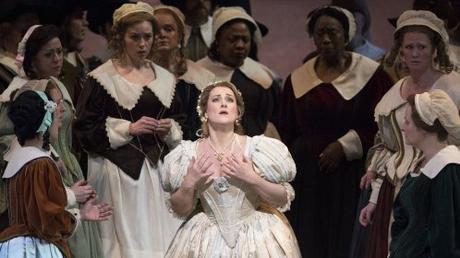
(Photo: Marty Sohl, Metropolitan Opera)
But the obvious star of the afternoon was Camarena. There has never been a better sung nor more gorgeously inflected reading of this part in my fifty years of listening. High notes held no terrors for the tenor. Although he skipped the high F in “Credeasi misera” (for which a fan, at the first performance, expressed his indignation), Camarena kept his focus on a classical line throughout. He never shied away from caressing the notes and resisted the temptation to belt out his high Cs and Ds. Everything flowed in an orderly, smooth fashion. He even lavished care for the text, a critical part of the whole in these fragile pieces.
Less in More, More or Less
Before I delve into the specifics of the other radio performances, a word about the premier broadcast of Puccini’s Manon Lescaut, which kicked off the season on December 3, 2016. It happened to be Russian diva Anna Netrebko’s role debut. Acquitting herself well in the part, the estimable Netrebko broke no new ground as far as insight and virtues were concerned. She was partnered by the able Argentine tenor Marcelo Álvarez as Des Grieux and by British baritone Christopher Maltman as Lescaut. The conductor was Marco Armiliato.
Álvarez is one of those artists who believe in the “less is more” school of singing. Continuously preserving his sound and husbanding his resources, Marcelo took on the Chevalier des Grieux, a most challenging assignment for any singer, with gusto and full-throated abandon. He surprised listeners (including yours truly) with a convincingly committed portrayal of the lovesick young student. The highlight was his Third Act oration, “Guardate, pazzo son,” sung with refinement as well as bronze-toned refulgence. His nonetheless valid interpretation, while smoother and less obviously strained than that of French tenor Roberto Alagna’s emotionally explosive version (see my review of his performance: https://josmarlopes.wordpress.com/2016/08/13/manon-lescaut-madama-butterfly-and-the-mets-latest-love-couple-part-one/), was a major triumph.
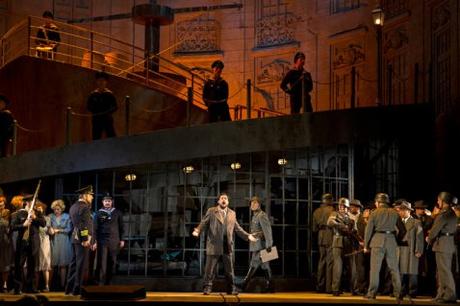
The most frustrating aspect of that performance, to my dismay, was the lackluster conducting of the usually competent Marco Armiliato. Perhaps I’m unfairly comparing his duties to the achievements of his predecessor in this regard, Fabio Luisi. Maestro Luisi was passed over for promotion by an unappreciative Met Opera management for his assignments in the French and German wing — in particular, to Berlioz’s classically structured Les Troyens and Wagner’s Ring, for which he added unexpected pleasures. Moreover, the knowledge and understanding he has brought to the Italian repertoire —i.e., the double bill of Cavalleria and Pagliacci, and the marvelously telling string section of Manon Lescaut — made those hoary works soar as they never had before.
The tricky key changes and give-and-takes in the third act trio between Manon, Des Grieux and her brother Lescaut; that stop-and-go aspect indicative of the couple’s desperation in their attempt to flee Geronte’s wrath before the police arrive, completely fell apart without Luisi’s firm hand at the helm. Don’t misunderstand me: I have the greatest respect and admiration for Maestro Armiliato. So the only possible explanation I can fathom for his failure to ignite this scene was insufficient rehearsal time.
The New and the Old
I’m all for new works, especially when they offer variety and another point of view. But the December 10 broadcast of Kaija Saariho’s L’Amour de Loin suffered from a sameness of sound throughout its presentation. With only three roles to contend with, the opera felt stagnant and unrelievedly boring.
Bass-baritone Eric Owens, normally an attention-grabbing, solidly opulent singer, was dull and stiff on stage. He’s supposed to be a troubadour-prince. Now, if there’s something that Owens is NOT is a romantic figure, especially a troubadour-prince. Consequently, there was little chemistry between him and his lady fair, soprano Susanna Phillips. One could blame it on miscasting, but this was a tedious affair from start to finish. True, the opera might be better off with different artists (as some critics have saliently suggested), but I’m not sure that would help its survival in the long run. It failed to stir these old bones.
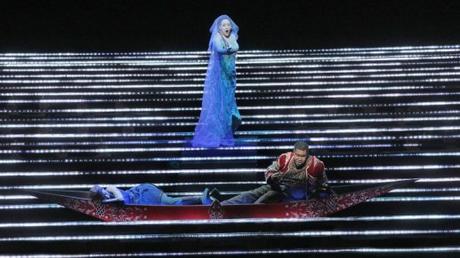
Moving on to the December 31, 2016 broadcast of Rossini’s L’Italiana in Algeri, I felt the opera deserved more bounce and flair, and several shades more of flamboyance and panache than it got. It also required a major bass-baritone with the requisite bel canto proficiency. Such was not to be found in the otherwise adequate hands of Ildar Abdrazakov as the pompous Mustafà.
To a similar degree, the squishy diction and shaky tones of Russian basso Mikhail Petrenko nearly sunk The Barber of Seville broadcast of January 28, 2017. Fortunately, that opera can survive just about anything that is thrown at it. And what was thrown included a fine, young Rosina in Pretty Yende (now THERE’S an attention-grabbing moniker!), the practiced Figaro of Peter Mattei, and the superlative vocal skills of Javier Camarena’s Count Almaviva. But a close shave is a close shave!
I did not hear either the February 4th Rigoletto or the February 11th Carmen broadcasts. But I am told that tenor Stephen Costello as the Sinatra-inspired Duke of Mantua managed to cut a trim figure on stage. He did over-extend his pleasingly lyric voice to the breaking point, however, in trying to outdo his predecessors. Not a wise move, Stephen! Besides, Polish tenor Piotr Beczała and the American Matthew Polenzani are hard acts to follow. Do yourself a favor and follow Frankie’s example: do it your way.
On the other hand, Massenet’s Werther from March 4 was graced with Vittorio Grigolo’s passionately dedicated, romantically justified interpretation of the title character, with fine support from David Bizic as Albert and Maurizio Muraro as the Bailiff. The opera was conducted by Edward Gardner.
The only letdown, if one could be honest, was in mezzo-soprano Isabel Leonard’s blandly conceived Charlotte. With such an outgoing protagonist as Signor Grigolo by your side, many reviewers noticed that Leonard was inhibited in her actions. I can’t judge her performance from that angle, but what I can say is that vocally she was about as effective as her predecessor Sophie Koch had been. Of course, Ms. Koch had to contend with the darkly handsome, and compellingly delivered Werther of a certain Jonas Kaufmann — an unfair matchup even in the best of times.
(End of Part Three)
To be continued…
Copyright © 2017 by Josmar F. Lopes
Advertisements
